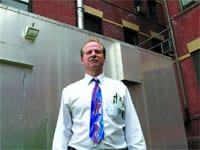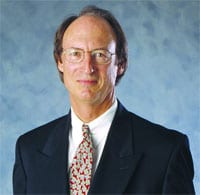Lessening the Load Holyoke Medical Center Seeks Energy Efficiency, Cost Savings
Every now and then, Holyoke Medical Center fires up its emergency generators and relies on them to provide a few hours of power to the campus.
It doesn’t have to. But doing so provides valuable practice — and saves the organization some money, too.
“Since July 2007, we’ve been participating in the ISO New England demand-response program,” said John Therrien, director of Plant Operations at the hospital, referencing the company that oversees the region’s electrical grid.
“We’re on call with our generators to reduce our electric use during periods of peak demand, which happens mostly in the hot summer months, when we’re using a lot of electricity for air conditioning and cooling,” Therrien continued.
When the call comes in, the generators switch on, and the hospital pulls that much less power from the grid. It’s critical practice in case of a regional energy crisis, and the Joint Commission on the Accreditation of Healthcare Organizations requires hospitals to periodically run their generators anyway. But it’s also a money-maker.
“They give you notification — the minimum amount is 30 minutes. So if you had 30 minutes notice, you would have 30 minutes to get the generators started and online to reduce the electric load off the grid,” said Therrien. “Most of the time, they give you more time than that. When they have an event, they pay you money for the actual reduction of electricity you’ve taken off the grid, and they also pay you quarterly for the capacity payments, basically for being on call throughout the year.
“Because it reduces the electricity from the grid, now these big power plants will actually save money on their end because they’re not having to run as much electricity out to the main power plants throughout the state and New England,” he added. “It’s a win-win situation because, under the requirements of the Joint Commission, we have to run our generators for so long anyway. So now we’re running our generators and getting paid for it. It’s a win for us.”
It’s also only one of the ways HMC, like many hospitals, is tackling the issue of high energy costs — and demonstrating how it’s going green in more ways than one.
Generating Change
The network that would eventually become ISO New England was created more than 40 years ago to manage the region’s electrical grid, so that power will always be available to consumers.
As a regional transmission organization, the Holyoke-based company manages the six-state region’s bulk electric power system, directing the generation and flow of electricity across its interstate high-voltage transmission lines. The company also oversees New England’s wholesale electricity marketplace, where power is bought, sold, and traded on a daily basis.
Specifically, ISO New England manages the electrical supply of 6.5 million households and businesses across its six states. Its regional power grid includes more than 350 separate generating plants and more than 8,000 miles of interconnected transmission lines.
That’s a large network to manage, which is why officials there look for ways to ease the burden on the grid.
“If they had a problem with some of their electrical equipment, that could be a potential call to us, to say, ‘we’re having problems, so be warned: you could potentially be called today,’ and we’ll be prepared in case we have to start the generator,” Therrien said. “Sometimes what happens is, if you don’t have an actual event, they’ll do a scheduled event anyway, just to make sure everyone who says they’re participating does so, and that their system is working properly.
“They contact you through E-mail, beepers, cell phones, and you have to call in and say you got the message, and you’ll be participating in it,” he added. Typically, the generators run for a few hours before the drill is concluded.
Therrien’s role, however, goes far beyond generators. In fact, it’s a constant challenge to determine where his department can conserve energy — and save money.
According to hospitalmanagement.net, hospitals are the second-highest energy-intensive space type, per square foot, in the U.S., and the fourth-most carbon-intensive overall. And that impact is rising; surveys suggest that 90{06cf2b9696b159f874511d23dbc893eb1ac83014175ed30550cfff22781411e5} of all hospitals in a given year see energy costs increase from the previous year — a significant drain on the bottom line.
In an article on that Web site, Clark Reed, national health care manager at Energy Star, says hospitals can’t rely on excuses like a building’s age when avoiding taking steps toward energy efficiency.
“An old building with old equipment that is maintained and operated in a superior fashion performs much better than a new building that is not run well,” he notes. “Modern equipment will naturally be more efficient, but that does not necessarily mean it is being properly utilized.”
He also outlines several steps hospitals need to take to become more efficient. They include replacing inefficient lighting, installing energy-efficient appliances and equipment to reduce plug load, installing solar panels or white roofs, right-sizing cooling fans, and upgrading heating and cooling systems.
Seeing the Light
Many of those improvements are familiar to Therrien.
“We’ve done several different programs here at Holyoke,” he said. “We’ve done an energy-efficient lighting program where we changed out our old magnetic T12 ballasts with new electronic T8 ballasts over 3,500 fixtures changed out.”
A lighting ballast is a piece of equipment required to control the starting and operating voltages of electrical gas-discharge lights, such as fluorescent lamps. Electronic ballasts are more efficient than magnetic ones.
“That was an energy-saving project,” Therrien said, adding that existing lighting was changed out to LED lighting, which is a another big energy savings. “We used motion sensors for lights in the hallways and in unused areas like conference rooms, so anytime these areas are used now, the lights will shut off and turn on when someone enters the room.”
“All inefficient lights need to be replaced,” Reed notes at hospitalmanagement.net. “It is also a question of control. Features such as installing occupancy sensors in public spaces can offer massive savings.”
In another project at HMC, Therrien said, “we put in variable-speed drives on our air-handling cooling tower fans; we also have an energy-management system for the HVAC system that controls hearing and cooling settings.”
Also, when the hospital performed its last round of renovations throughout the complex, “we changed our toilets from 3.6-gallon flushes to energy-conservation toilets that hold 1.6 gallons. So basically, you’re saving two gallons with each flush.”
Meanwhile, Therrien addeed, “we changed the boiler room’s deaerator storage tank.” A deaerator is a device used for the removal of air and other dissolved gases from the feedwater to steam-generating boilers. Dissolved oxygen in boiler feedwaters can cause corrosion damage in steam systems.
“That other tank was oversized, so we put in a more-energy-efficient tank, and that saved a great deal of money for the hospital,” he explained. “The hospital is committed to projects such as that.”
Lessening one’s impact on the environment is certainly a trendy goal. But at a time when hospitals are especially strapped for cash, energy efficiency is also a good way to preserve a different kind of green.



Comments are closed.